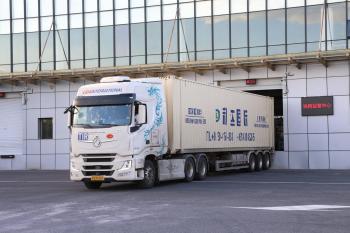Fast, secure, reliable. The TIR system is driving ever more trade with China through new routes.
Following a strong 2024, the global TIR transit system continues to gain momentum in China. Between January 2024 and July 2025, the number of licensed TIR operators increased by nearly 600%, while the number of TIR vehicles surged by almost 1200%.
Here are five new trade routes made possible by the TIR system.
1,200km per day
Marking Guangzhou’s first-ever TIR movement, a Chinese operator successfully transported live plants to Almaty, Kazakhstan. The five-day journey included the Khorgos Port and spanned over 6,000km – averaging an impressive 1,200km per day.
As the Greater Bay Area expands its international logistics capabilities under the Belt and Road Initiative, Guangzhou’s adoption of TIR is a major boost to its growing role as a global trade hub.
Delivered fresh
A Chinese operator transporting frozen meat has opened a TIR route from Orsha (inland Belarus) to Qingdao (eastern China).
The 10,000km journey took three weeks, cutting the transport time by around 15 days compared to traditional sea freight.
TIR’s door-to-door cold chain delivery capability is essential for food safety, freshness and efficiency.
First export

Following its first TIR import in 2024, Shanghai has now completed its first TIR export.
A TIR truck transported three heavy-duty vehicles from Shanghai to Minsk, Belarus.
The 10,000km journey took only 13 days.
New hub route
The Linyi TIR Logistics Hub has opened a new route to Almaty, Kazakhstan, via the Khorgos Port.
The five-day road journey outpaces the equivalent rail transport, which takes 15-20 days.
The Linyi hub now works with six TIR companies (total of 146 vehicles), serving Central Asia and Europe.
9610 e-commerce

A TIR vehicle carrying e-commerce parcels has returned to Zhejiang province, marking China’s first TIR 9610 e-commerce import and Zhejiang’s first-ever TIR import operation.
When overseas buyers cancelled their orders (cancellations of e-commerce goods are a common practice), the goods were returned to Yiwu under TIR, reducing logistics costs by 40% compared to the original export process.
9610 refers to a simplified customs clearance code in China for cross-border e-commerce, allowing small-parcel businesses to streamline declarations.
What is TIR?
The United Nations-backed TIR system enables goods to be shipped from a country of origin to a country of destination in sealed load compartments that are controlled by customs via a multilateral, mutually recognised system.
TIR streamlines procedures at borders, easing the administrative burden for customs authorities and transport and logistics firms. It significantly reduces border waiting times, saving both time and costs.
Processing TIR at inland customs offices in China is especially beneficial for out of gauge goods, perishable food, dangerous goods, e-commerce, precision instruments and other goods with high requirements for transport safety and timeliness.
